|
 Secure Site
Secure Site
|
 |
Archive for the 'Chime Alarm Clocks' Category
 mindful eating Conscious eating
Just as you bring mindfulness to your yoga practice, you can be mindful at mealtime. Yoga philosophy and all of the world’s healthiest diets recommend a conscious eating practice for optimal health. Mediterranean cultures traditionally regard meals as experiences to be savored and a life pleasure meant to be enjoyed. Asian cultures consider eating an aesthetic experience and reverentially enjoy beautifully prepared and presented foods that nourish the senses—to see, smell, touch, taste, and observe any sounds—while slowly eating the meal.
The Slow Food movement is reviving and sharing the benefits of conscious eating and the enjoyment of wholesome foods. Slow Food USA, part of the international Slow Food movement, is dedicated to supporting local farmers, the production of regional foods, and small producers. The movement promotes a slower lifestyle that cultivates time for conscious food preparation and eating, and opposes the fast life exemplified by corporatized foods and degradation of farmland.
 conscious eating, a mindfulness practice Eat Here Now
How can you incorporate mealtime mindfulness into your own life? Try the following essential components of a conscious-eating practice.
1. Schedule time for meals. Allocate at least twenty minutes each for meals and/or enough time to truly experience the food you eat. Avoid overeating. Set your Zen Timer for at least 20 minutes.
2. Eliminate distractions during meals. Eat slowly in a calm, quiet environment without a blaring television, loud music, or your computer as an accompaniment. The experience of the meal should be the focus of your attention and entertainment.
3. Enjoy conscious eating. Practice a state of awareness while you eat. Savor the appearance, smell, and taste of your food, so you can be truly satisfied. Chew each bite twenty times, which will help digestion and keep your attention in the moment. Enjoy the rasa, or “juice” of the food, through our senses.
4. Practice snacking awareness. Avoid mindless snacking, eating while you’re talking, and snacking just because food is present.
5. Use tasteful presentation. Small portions beautifully arranged on an attractive plate nourish the senses and encourage you to savor each bite.
6. Practice cooking meditation. Feed your soul by incorporating mindfulness as you cook. Allow cooking to express your love and be the ultimate gift to others, as the food we eat literally becomes a part of us physically, mentally, and spiritually, in our cells, skin, bones, and thoughts.
7. Count your blessings. Before your meal, experience a moment of thankfulness for having food.
adapted from Natural Home Magazine, November/December 2005 by Elaine Gavalas
 Bamboo Zen Timers with Chime Now & Zen
1638 Pearl Street
Boulder, CO 80302
(800) 779-6383
Posted in Beauty, Chime Alarm Clocks, intention, Meditation Timers, mindfulness practice, Well-being, Zen Timers
 Set your Zen Alarm Clock at Night Today, in our too-fast, information-overloaded society, we’ve lost much of our connection to the Earth, to spirit, to nature’s cycles, to our own cycles. And yet, we still need things to feed us, to ground us, to give us courage and connection.
Good rituals are essential to our emotional, psychological, and spiritual health. To help reconnect us to the sacred aspects of our lives, we asked an expert to share everyday rituals that they’ve created or practice.
Sleep Practice
Bedtime is when we drop our defenses and become vulnerable. This is why most religions have a tradition of bedtime prayers, says Alexander. Today, she believes, most insomnia and disturbed nights are caused by overactive minds mulling over the day’s problems.
 chime alarm clock for a peaceful sleep
Intention
To mark the break from day to night and ease into a state of physical and mental relaxation.
Materials
Lavender oil, notebook, and writing utensil.
Steps
1. Change (or bathe) with intention. As you take off your clothes, visualize all your daytime anxieties and concerns dropping away. As you wash, imagine that you cleanse away all the negativity of the day.
2. Write down all the positive things that happened during your day.
3. Dab the Lavender oil on a handkerchief and place it near the bed. Lie down, breathe in the soothing scent of the oil, and cast your mind back over the day without judgment.
4. Set your Zen Alarm Clock to the time you need to wake up in the morning right before you go to bed. Use your Zen alarm clock to not only wake you up gradually in the morning, but as a blocker of all negativity. When your alarm clock is set, don’t think about your problems or agenda for tomorrow; instead concentrate on your breathing so you fall asleep peacefully.
Now & Zen Alarm Clocks has adapted this from Body + Soul Magazine
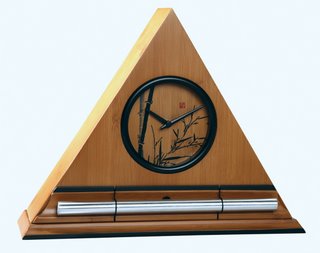 Chime Alarm Clock For a Progressive Awakening Now & Zen
1638 Pearl Street
Boulder, CO 80302
(800) 779-6383
Posted in Chime Alarm Clocks, intention, mindfulness practice, Now & Zen Alarm Clocks, Progressive Awakening, sleep, Sleep Habits, wake up alarm clock, Well-being
 a walking practice You know that a brisk walk around the block can clear your head. But it can do even more. Walking rivals yoga, meditation, and tai chi as a powerful mindfulness practice, says Danny Dreyer, a running coach, ultramarathoner, and creator of the ChiRunning and ChiWalking programs. Dreyer has spent years teaching people how to use walking to relieve physical and mental stress by moving in a relaxed way and focusing on physical sensations.
In the following exercise, Dreyer shows how to elevate a simple walk to a meditation in motion, just by using breath and awareness to target tension and trigger the body’s relaxation response. Try this simple stress reliever before an important meeting, after a workday, or any time you need to recapture a calmer, more centered state of mind.
Find a Quiet Place
Choose to walk somewhere soothing — around a lake instead of along a busy road, for instance.
Tip: Don’t rush. Your goal here is to unwind, not to break a sweat or clock in miles. Do your best to maintain an easy gait.
Go Easy
Keep your pace comfortable (as if you don’t need to get anywhere fast) and your stride short.
Breathe Away Tension
Start with your head and observe any tension you might be feeling there. Take a deep inhale, and then with each exhale, imagine releasing tightness in your head and neck. Continue with your shoulders, arms, chest, belly, glutes, upper legs, lower legs, and feet. Spend several breaths on each area, gradually inviting every part of your body to relax. Repeat this exercise.
Take Time to Unwind
Walk for at least 15 minutes, or longer if you have time.
Tip: Focus on tension hot spots throughout your body; this will help you open up and unwind.
adapted from Body + Soul Magazine, September 2007 by Kate Hanley
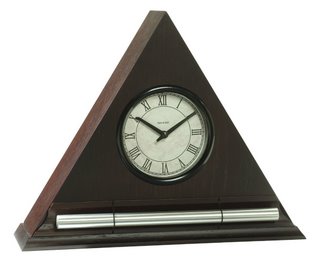 Dark Oak Zen Alarm Clock with Chime, a Meditation Timer
Now & Zen
1638 Pearl Street
Boulder, CO 80302
(800) 779-6383
Posted in Chime Alarm Clocks, intention, Meditation Timers, Meditation Tools, mindfulness practice, Now & Zen Alarm Clocks, Well-being, Zen Timepiece by Now & Zen, Zen Timers
 mindful walking Whether you’re staring at a blank page or stuck on a problem, a walk may be just the thing you need to bust through a roadblock. It can even set the stage for inspired thinking and major mental breakthroughs, says Thom Hartmann, author of “Walking Your Blues Away,” by giving you access to the full range of your thought power. “When we walk, we stimulate portions of the brain in the right and left hemispheres, giving us access to more areas of our brains than when we’re sitting still,” he explains. “A million years of evolution have equipped our bodies to operate in an optimal way when we’re walking,” he says. “It’s part of our body’s normal restorative process.” Here are his guidelines for using your daily walk to get out of a mental rut and lure your creativity out into the open.
Skip the Distractions
Wear comfortable clothing, don’t carry anything, and leave the iPod at home. This helps you stay open and balanced so you can focus.
Set a Comfortable Pace
Walk at your normal pace, which helps you sync to your body’s other rhythmic processes, such as heartbeat and breathing rate, which further creates the conditions for insight to occur.
Visualize Your Dilemma
As you’re walking, call up the issue or idea you need clarity on. It can be as richly detailed as a mental image (seeing the finished letter, signed and sealed) or as simple as a question (“What should I say to this person?”). Your mind will inevitably wander; let it. Then, gently guide your thoughts back. Hartmann explains that this interplay between conscious thinking (going over the main points in your mind) and unconscious thinking (daydreaming) brings your whole brain into play and opens you up to inspiration.
Take Your Time
According to Hartmann, the average length of time people require to have a burst in creativity is 15 minutes, or about a mile of walking.
adapted from Body + Soul Magazine, September 2007 by Katie Hanley
 Digital Zen Alarm Clocks, meditation timers and alarm clocks with chimes
Now & Zen
1638 Pearl Street
Boulder, CO 80302
(800) 779-6383
Posted in Chime Alarm Clocks, intention, mindfulness practice, Now & Zen Alarm Clocks, Well-being, Zen Timers
 Labyrinth, meditative walking St. Augustine, a fourth-century theologian, once proclaimed, “Solvitur ambulando”, or “It is solved by walking.”
In few lives is that statement more compelling than in Ellen McDermott’s. In November 1993 a stroke left the San Francisco resident impaired on her left side. She turned to labyrinths, a form of walking meditation, for healing. “I was drawn to labyrinths before my stroke because of their soothing meditative quality, but after the stroke I needed healing and the labyrinth became even more important then,” she says. “In my recovery I used conventional medicine, physical therapy, prayer and other spiritual practices, but walking the labyrinth was different. It was definitely unifying—the one thing that brought all the different aspects of healing together,” McDermott says.
Over several months of walking the well-known labyrinth at San Francisco’s Grace Cathedral, McDermott regained her physical strength. But the healing went much deeper. “Walking the labyrinth helped me move beyond my physical body to find comfort, peace and confidence. I guess you could say it healed all of me,” she says.
One path, endless potential
As one of more than a million people in this country who have walked a labyrinth, McDermott joins many pilgrims past and present who have found solace and strength through labyrinth journeys.
To walk a labyrinth, it’s necessary to follow a path through an intricate pattern until you reach the center. Many people confuse labyrinths with mazes, yet critical differences separate the two. Mazes are “multicursal,” which means you must choose among many possible paths once you enter, explains Helen Curry, author of The Way of the Labyrinth: A Powerful Meditation for Everyday Life (Penguin Compass, 2000). Wrong turns and blind alleys are common in mazes, so is getting lost or disoriented, she adds. Whereas mazes are mental, linear, left-brained experiences, a labyrinth’s path is soothing, rhythmic and meditative, says Curry, who alsois the founding president of the global Labyrinth Society and executive director of The Labyrinth Project of Connecticut Inc. It’s not possible to get lost in a labyrinth. Although some turns take you away from the center, your path is nonetheless sure, safe and gently guided, both in and back out again.
Labyrinths can be made of cloth or bricks; carved into stone floors, hillsides or walls; cut into living garden turf; or even woven into baskets. Circular labyrinths have a varying number of concentric rings, or circuits. The seven-circuit design (pictured below) is the oldest, dating back several thousand years, according to the Rev. Lauren Artress, president and founder of the nonprofit organization Veriditas, The Voice of the Labyrinth Movement and author of Walking a Sacred Path: Rediscovering the Labyrinth as a Spiritual Tool (Riverhead Books, 1996). The 11-circuit version (pictured on page 43), like the world-renowned labyrinth at the Cathedral of Chartres in France, most likely became well known around the 9th century. Recently, Curry developed a smaller three-circuit design for use in ceremonies such as weddings.
As a walking meditation, a labyrinth is similar to sitting meditations in its healing capacity, yet wonderfully different in its accessibility. “For me, walking the labyrinth is more available and effective than sitting meditation,” Artress says. “It makes quieting my mind and being able to harness the power of concentration much easier.”
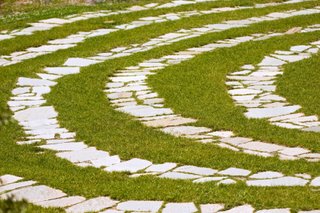 a spiritual practice, mindfulness walking Anchored in history, reborn in the present
“No one is quite sure how and where labyrinths were born,” Artress says, “but of the 80 cathedrals that went up in the Middle Ages, we do know that 22 of them had labyrinths.” Some evidence suggests these medieval church labyrinths were used symbolically to represent the journey to God. Other stories passed down through generations indicate ancient cultures from Rome to Scandinavia used labyrinths for good fortune, protection or healing.
“In the United States we’ve seen quite a strong labyrinth revival over the last 15 years,” says Sudha Carolyn Lundeen, CHN, RN, a certified holistic health nurse and the labyrinth workshop leader at the Kripalu Center for Yoga and Health in Lenox, Mass. But as Artress notes, it wasn’t until 1998 that the New York Times officially labeled this revival “The Labyrinth Movement.”
“There are now more than 1,600 labyrinths in the worldwide locator’s database,” Curry says. “And more added daily in prisons, private and public gardens, schools and hospitals.”
 labyrinth by the sea Why labyrinths now?
People are hungry for a richly symbolic life, especially for symbols that offer meaning and comfort, Artress explains. And “as an archetype of wholeness and unity as well as a metaphor for life’s path, the labyrinth…offers a spiritual experience not tied to any particular religion or culture,” she says.
“The labyrinth also offers much-needed psychospiritual healing,” Artress notes. And sometimes it even helps identify issues that need attention. “When those issues surface,” she says, “it’s important to go in and visit them. What are they trying to tell you?”
One night, Barbara Stephen Davis, an English-as-Second-Language teacher in Galveston, Tex., learned how physical feelings can speak volumes within the labyrinth’s sacred space. Even though she normally looked forward to the walks, Davis, also a labyrinth facilitator, felt reluctant to participate that evening in the full-moon labyrinth walk at the University of Texas Medical Branch campus. “It was 2004 and a stressful time in my life,” she explains. “I was processing through some personal issues, working long hours and definitely not taking good care of myself.” To top it off, the back pain that had plagued her periodically was particularly intense that night. “In retrospect I can see I was burned out and repressing a lot of feelings. Who knows, maybe the back pain was a physical metaphor for my life pain,” she says.
“But the moon was amazing, very full, bright and a glowing white,” Davis continues. Captivated by the evening, she did walk after all. Yet with every turn of the labyrinth’s path, the tightness in her back worsened. Even though it didn’t make sense given her physical condition, something told Davis to sit awhile once she reached the labyrinth’s center. “I can’t really explain what happened while sitting there,” she says, “except that I felt somehow outside myself as I yielded to the clouds going back and forth across the moon.” Yet the real gift came when she got up to make her way out of the labyrinth. Her back pain was completely gone, and so far it has never returned. “It was like the labyrinth helped me see the pain in my life and release it,” Davis notes.
Guidelines for the journey
To realize the labyrinth’s potential in your life, simply walk it and let the event unfold. There is no right or wrong way to walk a labyrinth, Curry says, but there are some guidelines that may enrich your journey. Start by quieting your mind and deciding what you hope to gain from the experience. Are you seeking an answer to a question or guidance on a life decision? Perhaps you’re using the opportunity as a celebration or part of a spiritual ritual. Whatever the purpose, use it as your intention while guarding against expectations.
Healing is a very individual process, Californian McDermott notes, and not everyone thinks about his or her walk in stages. “I did, though,” she says, “and as I walked into the labyrinth I learned to let go of all the anger and frustration I felt over not being myself. My quiet time in the labyrinth’s center helped me regain my own center, and the path out was like my path in life, learning to go forward from here.”
Although some walks are life changing, they don’t all have to be dramatic, she says. “It’s the sureness of the labyrinth’s path that I count on when the rest of my life is uncertain. It’s like going home.”
The labyrinth as a healing tool
Scientific research delving into the labyrinth’s healing powers is just beginning, and, in a ground-breaking pilot study conducted at the University of Texas Medical Branch (UTMB) in Galveston, Texas, M. Kay Sandor, PhD, RN, recently became the first researcher to document evidence of its rejuvenating capacity. Sandor, an associate professor in the School of Nursing at UTMB and a nurse psychotherapist, explains that the study found a small decrease in breathing rate and improvements in mood profiles of the participants, after the labyrinth walk.
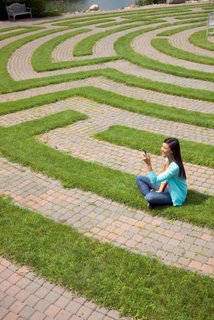 grass labyrinth Meanwhile, progressive hospitals didn’t wait for research proof before providing a labyrinth for their patients and staff. In 1998, California Pacific Medical Center (CPMC) in San Francisco became the first U.S. hospital to construct a labyrinth on their grounds, says Dennis Kenny, director of the CPMC Institute for Health and Healing’s Integrative Clinical Education and Spirituality Program. Others have followed, like Mercy Hospital Grayling in Grayling, Mich., and Legacy Meridian Park Hospital in Tualatin, Ore. “We made the labyrinth accessible to anyone, placing it at the entrance to the hospital, right outside our main lobby and waiting area,” Kenny says. “Cutting across spiritual beliefs and backgrounds, it provides a respite for patients, patient families and hospital staff when they most need comfort and peace. In a setting like this, the labyrinth’s symbolic message is powerfully clear,” he says. “There is a sanctuary for you here, and we care for much more than just your body parts.”
Posted in Chime Alarm Clocks, intention
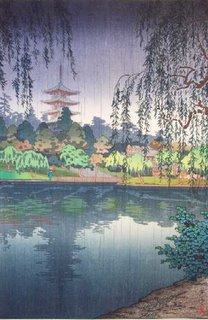 Kofukuji Temple, Nara Yokoi Outdoor rooms, porches, and pavilions let you come home again to the natural world. Let nature’s elements be your palette and sensory delight your touchstone.
Imagine waking up on a summer morning to a gentle breeze on your face, the chattering of birds, and the scent of flowers opening their petals to the dawn. You lie there, warm under your wool comforter, recalling the bliss of falling asleep with frogs croaking in the nearby pond as you gazed at the stars before closing your eyes. All this, yet indoor plumbing is only a few yards away. This is the joy of outdoor living spaces.
Outdoor rooms, porches, and pavilions are back in style. Tired of being cooped up, people are moving their dining, socializing, sleeping, and sometimes even work spaces outdoors. The success of these spaces depends a lot on understanding some basics about climate and design. If you want your investment in outdoor living to pay off, you’ll want a place that’s comfortable in a range of weather conditions.
Our ancestors, who lived without central heating and cooling, knew a lot about building sleeping porches, gazebos, and summer kitchens. These structures allowed them to escape their hot, stuffy houses in summer. After decades of burning fossil fuels with wild abandon to keep us warm in winter and cool in summer, we’re beginning to realize that these people were on to something. Well-designed outdoor rooms are the epitome of ecological design; they get their heat and light from the sun and their cooling from shade and breezes.
In fact, creating an outdoor space for your home is a great way to increase your grasp of climate-responsive design. It’s an exercise in paying attention to the ecosystems you participate in. By noticing where the prevailing winds come from, and by being aware of the sun’s path across the sky, you can create a garden room that keeps you dry in the rain, unruffled by the wind, cool in summer, and warm in all but the worst of winter without burning a drop of fuel.
Outdoor structures can also expand your home’s living space for much less expense than adding a normal room. And an attached outdoor room can increase your home’s energy efficiency by protecting it from heat, cold, and wind, or even—in the case of a sunspace—by collecting solar heat to be used indoors.
But that’s only the beginning. Outdoor living is also good for your health and well-being. Sunlight, fresh air, and greenery nourish body and soul. The sounds of birds by day and crickets by night, the scent of flowers, the feeling of warm sun and cool breezes on our skin, and the sight of birds, butterflies, and bees nourish our senses and restore our participation in the web of life.
 mother nature's living spaces Try this at home
If you have even a little bit of outdoor space around your home, you can enjoy these delights, too. Start by sitting in different parts of your yard. Notice which areas are sunny, shady, calm, windy, private, exposed, moist, or dry. Notice which spots have nice views, near or far. Think about access: Do you want to walk easily from your indoor kitchen to an outdoor dining room? From a sleeping porch to the bathroom?
When you select a place for an outdoor room, pay attention to how the natural elements interact with this spot, how they vary with the time of day and season, and which elements you’d like to temper for your comfort. Let’s say you want to build a pavilion in a corner of your backyard, but the prevailing wind comes from the northwest—which is exactly the direction of your favorite view. A glass wall on the northwest side will meet both your needs. Or maybe you want to create a warm spot for chilly evenings. You can build a curved stone wall that defines the space, blocks the breeze, and faces south to soak up the sun; build a stone bench against the wall, and you’ll have a toasty spot for relaxing at the day’s end. Overhead shade will make the same spot comfortably cool in summer.
Finally, consider having flexible elements that extend the usefulness of your outdoor space. Add removable glass to a screened porch to turn it into a sunroom in winter. Use heavy curtains in your pavilion to block breezes, rain, or prying eyes. Hang a seasonal cloth roof over a patio, or grow a deciduous vine on a trellis or arbor.
adapted from Natural Home Magazine, July/August 2004
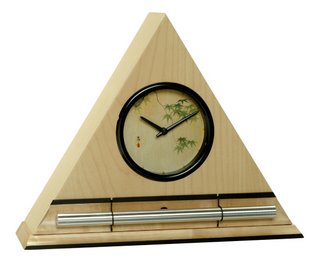 Japanese Maple Leaves Dial Face, Zen Wake-up Alarm Clock Now & Zen
1638 Pearl Street
Boulder, CO 80302
(800) 779-6383
Posted in Cherry Blossoms, Chime Alarm Clocks, Japanese Inspired Zen Clocks, Natural Awakening, Now & Zen Alarm Clocks, sleep, Sleep Habits, Ukiyo-e, wake up alarm clock
 entering silence, starry night in the wilderness How one woman survived three days in the wilderness—alone.
I shivered in the pitch-black night as a steady rain showered my head. I sank deeper into a state of abject loneliness with every miserable drop. My saturated sleeping bag weighed me down as I searched blindly for my flashlight, all the while berating myself for not tying up the tarp before I fell asleep beneath a formerly clear, starry night.
Feeling panicky on the first night of my solo experience in the woods, I imagined the worst—three days of rainy, damp desolation. What am I doing here? I wondered. I could be home, snuggled up with my husband in our cozy bed!
And then it hit me. I realized that this moment was exactly why I had come here—to face my demons head-on, to ride out the fear of being alone in the dark and of being eaten, possibly, by a bear. Isn’t that what a vision quest is all about? Flinging oneself into the wilderness (in this case, a California state park on Labor Day weekend, but still) to test one’s inner strength and hopefully receive some sort of life guidance, perspective, and inspiration?
For the last 10 years, I had contemplated embarking on a quest like this with awe and trepidation. An extrovert by nature, I thrive on the company of others. I can’t be alone in my own house for five minutes without feeling anxious, so how could I endure three entire days by myself? I feared I would go crazy with no one to talk to, engulfed by the deafening silence of nature.
To my surprise, I discovered that nature is extremely loud. Have you ever heard throngs of blue jays chattering overhead at the crack of dawn? I was definitely not alone—from the disturbed gopher under my sleeping bag (was I camped on his house?) to the constant parade of insects, birds, and critters, I was in a forest teaming with life and endless entertainment.
Two days later as I packed my gear, I had a hard time believing the time had passed so quickly. Suddenly the power of facing and overcoming my deepest fears overwhelmed me, and I fell to my knees sobbing. A strength I never knew existed inside me welled up as I realized I could now be alone and unafraid.
I shouldered my backpack, danced a little jig to celebrate my emancipation, and walked out of the wilderness a changed woman.
adapted from Natural Solutions Magazine, Sept. 2009 by Laura Gates
 Zen Alarm Clock, a natural chime sound alarm clock
Now & Zen
1638 Pearl Street
Boulder, CO 80302
(800) 779-6383
Posted in Bamboo Chime Clocks, Chime Alarm Clocks, Hokusai Wave, intention, Natural Awakening, Now & Zen Alarm Clocks, Progressive Awakening, sleep, Well-being
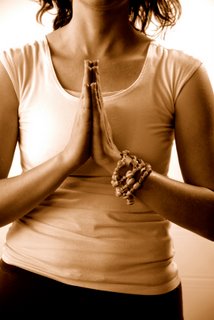 giving thanks Cultivating gratitude can boost well-being—and may help you sleep better.
Gratitude is a fundamental component of most spiritual paths, and a growing body of research suggests that it has important health implications, too, including better sleep, fewer physical ailments, and a greater ability to cope with stressful situations.
“Gratitude elevates, it energizes, it inspires, it transforms,” says Robert Emmons, a University of California, Davis, psychology professor who has helped champion the study of gratitude as a factor in mental and physical health.
A series of studies he conducted in 2003 found that people who kept weekly written records of gratitude slept longer, exercised more frequently, had fewer health complaints, and generally felt better about their lives when compared with those who were asked to record only their complaints. In another study, he found that students who wrote in gratitude journals felt more satisfied with their lives and their school experience.
Practicing conscious gratitude has also been linked with positive mental health. Todd Kashdan, associate professor of psychology at Virginia’s George Mason University, found that when veterans with posttraumatic stress disorder kept gratitude journals, they experienced a greater sense of overall well-being in their lives. “There are two parts of being grateful,” Kashdan says. “One is recognizing that someone benefited in some way, then mindfully seeing the connection to yourself. You have to really be in the present to see what’s happening in your life, what’s causing things to happen, and how you fit into things bigger than yourself.”
A gratitude practice is a natural companion to yoga, which “offers numerous opportunities to reflect on all there is in one’s life to be grateful for,” says Emmons. To begin consciously cultivating gratitude, try considering what life would be like without a pleasure you now enjoy, or think about who you are grateful for. A daily gratitude journal can help you be more mindful of these things in your life. But your gratitude practice doesn’t have to be scripted: Simply taking time on a regular basis to mentally note your blessings is a big step in the right direction.
adapted from Yoga Journal, by Jill Duman
Posted in Bamboo Chime Clocks, Chime Alarm Clocks, intention, mindfulness practice, Now & Zen Alarm Clocks
 Silk Lavender Eye Pillows Creating Eye Pillows:
Summer holidays are perfect times for craft projects. Here’s one you can do in an hour and use right away. Eye pillows are handy for traveling and for relaxing in Savasana.
Materials You’ll Need (makes one eye pillow)
For the pillow
1/2 yard of fabric that has been washed, dried, and ironed
For the filling
1/2 cup dried beans or flax seeds
1/2 cup dried rice, lentils, or buckwheat
1/2 cup dried lavender or chamomile
When selecting the filling consider the recipient’s scent preferences and any potential allergies. Mix together three or all of the above items. You’ll need 1 1/2 cups total.
 creating beautiful eye pillows Make the Pillow
Step 1 Cut the fabric
Using a ruler and pencil, mark two 4 1/2-by-10-inch rectangles on the wrong (nonprinted) side of the fabric. With a pair of scissors, cut along the marks to create the two panels needed for the pillow.
Step 2 Sew the seams
Place the two panels’ right (printed) sides together, with the raw edges aligned. Stitch a 1/2-inch seam around the raw edges, backstitching (sewing first in reverse, then forward over the same stitches) at each end. Leave one of the 4-inch sides open, so you can later add the filling. Stitch a 3/8-inch reinforcement seam around the raw edges, leaving the same 4-inch opening. This reinforcement will ensure that the mixture doesn’t leak out of the pillow after you’ve filled it.
With your scissors, cut two 1/4-inch notches in each seam allowance (the area between the stitching and the raw, cut edge of the fabric), one on either side of each of the four corners, making sure not to clip the stitching. Turn the eye pillow right side out for the next step.
Step 3 Fill the pillow
Spoon 1 1/2 cups of filling into the pillow’s open seam.
Step 4 Close the final seam
Fold each side of the remaining 4-inch seam 1/2 inch toward the inside of the pillow, and pin the opening closed. Either by hand or with a sewing machine, stitch a seam across the folded edges to close the 4-inch opening, then try out the pillow: Set your Zen Meditation Timer to 5 minutes, lie down, put it over your eyes, and treat yourself to 5 minutes of deep relaxation.
adapted from Yoga Journal, by Victoria Everman
 Zen Mediation Timers Now & Zen
1638 Pearl Street
Boulder, CO 80302
(800) 779-6383
Posted in Chime Alarm Clocks, Meditation Timers, Meditation Tools, mindfulness practice, Now & Zen Alarm Clocks, Well-being, Zen Timers
 Reiki Treatment Reiki, a Japanese healing treatment, quiets the body and spirit by tapping into a “life force.”
“Universal life energy” is what Reiki (pronounced RAY-kee) means in Japanese. Reiki practitioners use this energy-the subtle vibrational force that surrounds and permeates every living thing- to enhance and balance the body, says Susan Mitchell, a Reiki master and owner of Reiki Healing Arts in Coeur d’Alene, Idaho. “The practitioner acts as a conduit,” explains Beth White, a Reiki master in New York City. “During a session, the energy flows through the practitioner’s hands and you absorb it on a physical, mental, emotional, and spiritual level.” The result? A feeling of meditative peace.
Evidence
Reiki originated in Japan in the 1920s and was brought to the United States in the 1930s by Hawayo Takata, a Japanese-American. Although the studies of Reiki thus far have been small (five larger ones sponsored by the National Institutes of Health are under way), they indicate-as does strong anecdotal evidence-that the method is effective at reducing pain, anxiety, and stress, and increasing a sense of wellbeing. A study published last year in Integrative Cancer Therapies compared the effects of Reiki treatments with the effects of rest on fatigue, pain, anxiety, and overall quality of life in 16 cancer patients. Researchers found that the individuals who received Reiki experienced increases in quality of life and decreases in fatigue, changes that were not seen with rest alone.
Pamela Miles, a Reiki master in New York City and author of Reiki: A Comprehensive Guide (Tarcher, 2006), says the physiological changes seen following a Reiki session include a healthy decrease in heart rate and blood pressure and an increase in salivary immune hormones. “Reiki can help make your body’s self healing mechanism more effective,” she says. “Universal life energy” is what Reiki (pronounced RAY-kee) means in Japanese. Reiki practitioners use this energy-the subtle vibrational force that surrounds and permeates every living thing- to enhance and balance the body, says Susan Mitchell, a Reiki master and owner of Reiki Healing Arts in Coeur d’Alene, Idaho. “The practitioner acts as a conduit,” explains Beth White, a Reiki master in New York City. “During a session, the energy flows through the practitioner’s hands and you absorb it on a physical, mental, emotional, and spiritual level.” The result? A feeling of meditative peace.
 Reiki Evidence
Reiki originated in Japan in the 1920s and was brought to the United States in the 1930s by Hawayo Takata, a Japanese-American. Although the studies of Reiki thus far have been small (five larger ones sponsored by the National Institutes of Health are under way), they indicate-as does strong anecdotal evidence-that the method is effective at reducing pain, anxiety, and stress, and increasing a sense of wellbeing. A study published last year in Integrative Cancer Therapies compared the effects of Reiki treatments with the effects of rest on fatigue, pain, anxiety, and overall quality of life in 16 cancer patients. Researchers found that the individuals who received Reiki experienced increases in quality of life and decreases in fatigue, changes that were not seen with rest alone.
Pamela Miles, a Reiki master in New York City and author of Reiki: A Comprehensive Guide (Tarcher, 2006), says the physiological changes seen following a Reiki session include a healthy decrease in heart rate and blood pressure and an increase in salivary immune hormones. “Reiki can help make your body’s self healing mechanism more effective,” she says.
A typical session
During a Reiki treatment, you lie down on a massage table while the practitioner places her hands in various positions on your head, throat, and front and back torso. (Clients are fully clothed, unless Reiki is used in combination with another treatment like a massage.) You may enter a state of deep relaxation. Many people report seeing colors and moving shapes, sensing pulsations, and feeling hot or cold. In many cases, though, the result is improved energy and a sense of wellbeing. “I go into what feels like a deep sleep,” says Spiegler, “and an hour later I ‘wake up,’ feeling totally rejuvenated.”
adapted from Natural Health Magazine, August 2008 by Susan Hayes
 Bamboo Digital Chime Clock, a Reiki Timer and Clock Now & Zen
1638 Pearl Street
Boulder, CO 80302
(800) 779-6383
Posted in Bamboo Chime Clocks, Chime Alarm Clocks, intention, Japanese Inspired Zen Clocks, mindfulness practice, Now & Zen Alarm Clocks, Well-being
« Previous Page — « Previous Entries
Next Entries » — Next Page »
|
|
|
|